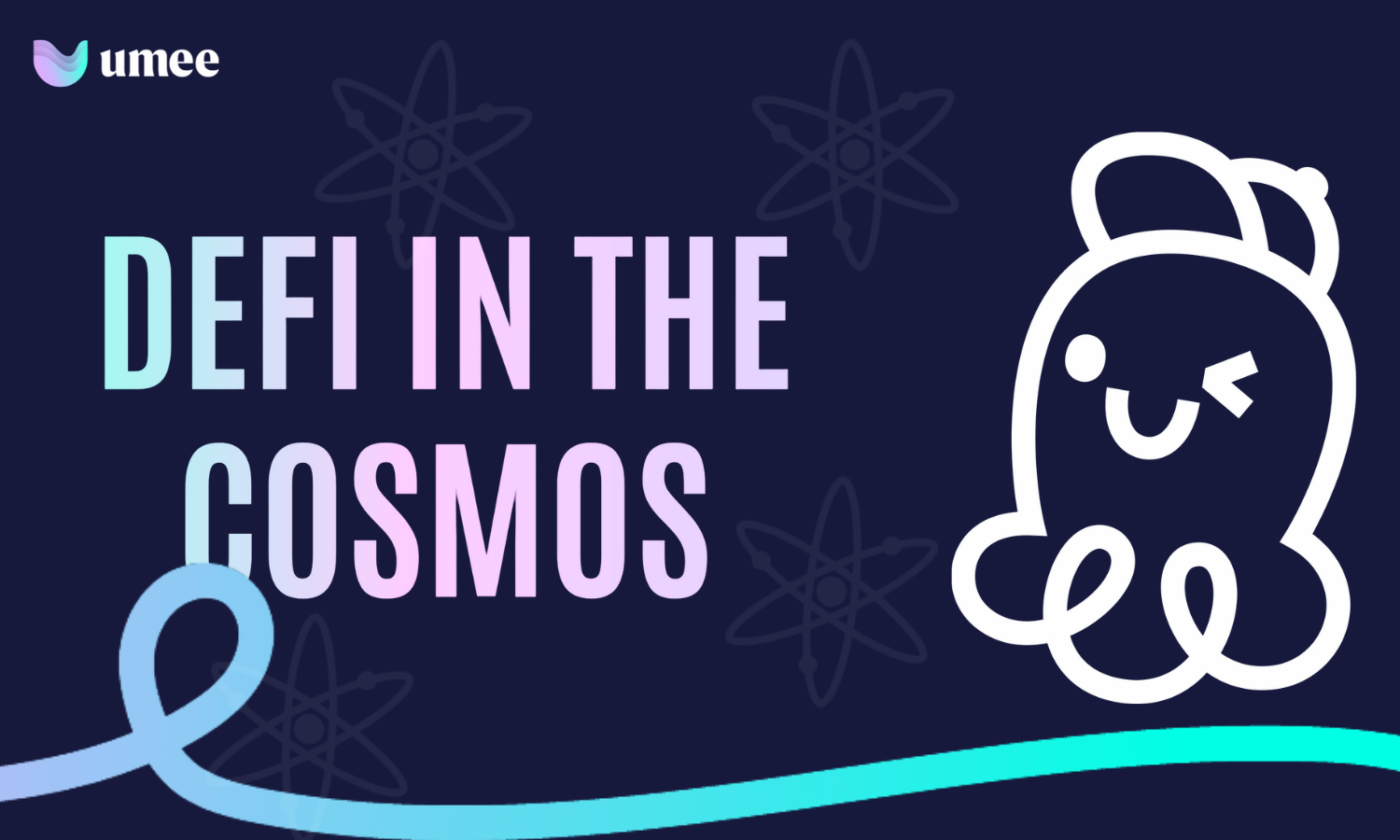DeFi in the Cosmos Ecosystem

The Cosmos Ecosystem is rapidly gaining popularity amongst crypto users and developers for all of the right reasons. As many DeFi users leave Ethereum in search of more user-friendly blockchains, several self-proclaimed Cosmos-based “DeFi Hubs” are welcoming them with open arms. Everyone who’s new to the Cosmos Ecosystem should familiarize themselves with the top Cosmos DeFi protocols before deciding where to park their funds.
While there are countless DeFi products available across almost every significant blockchain, Cosmos blockchains are usually optimized for one specific purpose. Let’s go through the top Cosmos blockchains for each major DeFi activity.
Umee
Primary Purpose: Decentralized Money Markets
Best Comparison: Aave as a base layer blockchain
Umee is a cross-chain lending and borrowing protocol built as a base layer blockchain which allows Cosmos users to lend and borrow just about any IBC-enabled asset. Umee aims to introduce traditional debt market fundamentals to the greater crypto ecosystem by creating a term structure that uses time-to-maturity and credit-worthiness to determine rates, and widely accessible crypto formats for traditional debt primitives like notes, bills, and bonds.
For the average Cosmos DeFi user, Umee provides lend/borrow markets for all relevant Cosmos assets including staking derivatives while setting a high bar for the quality of collateral assets to ensure ample liquidity is always available regardless of market conditions. As a base layer blockchain, all sorts of products can be built to take advantage of Umee’s deep liquidity and cross chain leverage abilities. Umee’s intense focus on security and asset risk makes it the primary contender as the interchain liquidity hub for the Cosmos Ecosystem and beyond.
For newer users, Umee is a good place to deposit stablecoins and unneeded assets in order to earn low-risk lending yield. For experienced users, Umee is the go-to Cosmos chain to access interchain leverage, and a good starting point for advanced Cosmos DeFi strategies.
Osmosis
Primary Purpose: Decentralized Exchange (AMM)
Best Comparison: Uniswap as a base layer blockchain
Osmosis is a base layer blockchain that serves as the go-to AMM-style DEX for IBC-enabled assets. Osmosis makes the DEX experience easy for both traders and liquidity providers alike, thanks to the simplicity of its UX. As the most popular DEX in the Cosmos Ecosystem, Osmosis is usually the first chain Cosmos chains connect to via IBC making it another liquidity hub of sorts.
Osmosis aims to maintain its status as the one-stop-shop for the purchase/sale of IBC assets by issuing generous liquidity mining incentives to its liquidity providers - Osmosis is known for matching the external liquidity mining incentives provided by projects who wish to bootstrap a liquidity pool. Osmosis liquidity providers are generally incentivized to provide liquidity for OSMO pairs, which makes it easy for users to trade between any two assets with minimal slippage.
For new users, Osmosis is the best place to trade major IBC-enabled assets with minimal slippage and low fees. For more experienced users, Osmosis is a good place to provide liquidity to earn trading fees and liquidity mining incentives.
Kujira
Primary Purpose: DeFi Hub
Best Comparison: Terra
Formerly built on Terra, Kujira was best known for its liquidation tool, ORCA, which allowed anyone to easily participate in the liquidation process for Anchor’s money markets. Following the collapse of Terra, Kujira was reborn as a layer one blockchain with a slightly broader scope.
As a base layer blockchain Kujira now offers a suite of DeFi products including an order book style DEX, an AMM optimized for stability and depth, easily accessible liquidation markets, and a decentralized over-collateralized stablecoin primarily backed by ATOM. While ORCA likely remains Kujira’s most attractive offering, Kujira has maintained a large active community of users from its Terra days and continues to ship new products for the Cosmos DeFi Ecosystem at a rapid pace.
Kujira is the best place for Cosmos DeFi users to easily access liquidation discounts on their favorite Cosmos assets.
Crescent
Primary Purpose: Decentralized Exchange (Hybrid AMM/Orderbook)
Best Comparison: Osmosis/Injective
Crescent is a Hybrid AMM/Orderbook DEX built as a base layer blockchain. Crescent’s goal is to provide the most capital-efficient and sustainable marketplace for cross-chain assets.
In Crescent’s hybrid model, liquidity pools simply act as another participant in an orderbook so the liquidity provided by users and traditional market makers can coexist. Additionally, different pools with the same asset pairs can use different configurations to participate in the orderbook simultaneously. This allows for higher levels of capital efficiency which enables traders to access greater liquidity with minimal slippage.
Crescent also offers ranged pools where liquidity can be concentrated within a certain price range. Ranged pools concentrate liquidity where it matters, which can be particularly useful for asset pairs that are meant to remain stable like wrapped tokens and staking derivatives.
In the near future Crescent plans to offer LF tokens which can be thought of as a more composable version of LP tokens. As IBC-enabled assets, LF tokens will enable even more capital efficiency for Cosmos DeFi users by allowing them to do things like collateralize their LP positions to borrow on chains like Umee.
Crescent’s LF tokens will enable unique new yield opportunities for Cosmos DeFi users.
Stride
Primary Purpose: Staking Derivatives
Best Comparison: Lido as a base layer blockchain
With PoS staking yields being among the steadiest and lowest risk yields available in crypto, token holders are often hesitant to sacrifice their staking rewards in order to use their PoS tokens in various DeFi activities. Stride is a liquid staking zone which allows users to easily stake their favorite Cosmos-native assets like ATOM in order to mint stTokens, the staking derivatives issued by Stride.
stTokens enable Cosmos DeFi users to participate in various DeFi strategies while maintaining their staking rewards, and may serve as an attractive form of collateral on money markets like Umee in the not-so-distant future. stTokens can easily be traded back for the underlying assets plus staking rewards accrued on DEXs like Osmosis, allowing users to bypass lengthy unbonding periods.
Stride’s staking derivatives allow users to participate in Cosmos DeFi without sacrificing their PoS staking yields.
Comdex
Primary Purpose: Synthetics
Best Comparison: Synthetix as a base layer blockchain
Comdex is a decentralized synthetics protocol built as a base layer blockchain. Comdex allows Cosmos users to tokenize real real world assets like oil, gold, and silver by facilitating the creation of collateralized on-chain derivatives called “cAssets.” Later on, Comdex plans to allow users to collateralize real-world assets as NFTs.
By creating on-chain derivatives for commodities, Comdex is bridging the gap between centralized commodities trading and DeFi. This allows CeFi users to experience the benefits provided by DeFi, and DeFi users to gain more exposure to real world assets without leaving the crypto world. Comdex’s cAssets can be used anywhere that chooses to support them across the Cosmos Ecosystem; for example, cAssets can be borrowed from the Umee Market and sold on a DEX like Osmosis in order to short the commodity it represents.
Comdex’s cAssets allow Cosmos users to gain exposure to commodities without leaving the Cosmos DeFi Ecosystem.
Shade
Primary Purpose: Privacy Preserving DeFi Applications
Shade can be described as “an array of connected privacy-preserving DeFi applications built on Secret Network.” Secret Network’s SNIP-20 token standard allows users to interact with applications across the Secret Ecosystem while maintaining their privacy - think Monero’s privacy plus Ethereum’s smart contract capabilities combined with Cosmos’ scalability and interoperability. Shade leverages Secret’s privacy-preserving features in order to offer privacy-preserving bonds, staking derivatives, and more.
Shade’s flagship product is SILK, a decentralized and overcollateralized stablecoin pegged to a basket of currencies and commodities rather than an individual currency. SILK uses the SNIP-20 token format to help DeFi users hedge against global volatility without sacrificing their privacy. Thanks to the high levels of interoperability provided by IBC, SNIP-20s will be available across the Cosmos Ecosystem in the near future, making Shade a noteworthy Cosmos DeFi project.
Shade is likely the best platform for Cosmos DeFi users who care about privacy. Shade’s upcoming stablecoin pegged to a basket of currencies and commodities may be an attractive alternative to USD-pegged stablecoins for Cosmos DeFi users.
Sommelier
Primary Purpose: Portfolio Optimizer
Best Comparison: Yearn as a base layer blockchain
Sommelier is a base layer blockchain that allows users to supply assets to be automatically deployed in advanced yield farming strategies on Ethereum. Yes, Ethereum. While Sommelier is a Cosmos blockchain, it acknowledges that the DeFi yields on Ethereum aren’t accessible for the average user and uses its Gravity Bridge to pass strategy instructions to Ethereum without actually bridging any funds.
Sommelier is obsessed with making its products incredibly easy to use. Sommelier goes a step further to make advanced DeFi strategies more accessible by tokenizing the strategies offered so they can easily be purchased on a DEX like Uniswap. While Sommelier currently only offers cellars (vaults/strategies) on Ethereum, it will offer cellars within the Cosmos Ecosystem in the future, and therefore is worth keeping in mind. For now, Cosmos users can stake their SOMM tokens on Sommelier to help secure the blockchain and earn a small portion of the yield generated from the strategies.
Sommelier will allow Cosmos DeFi users to easily take part in advanced DeFi strategies.
